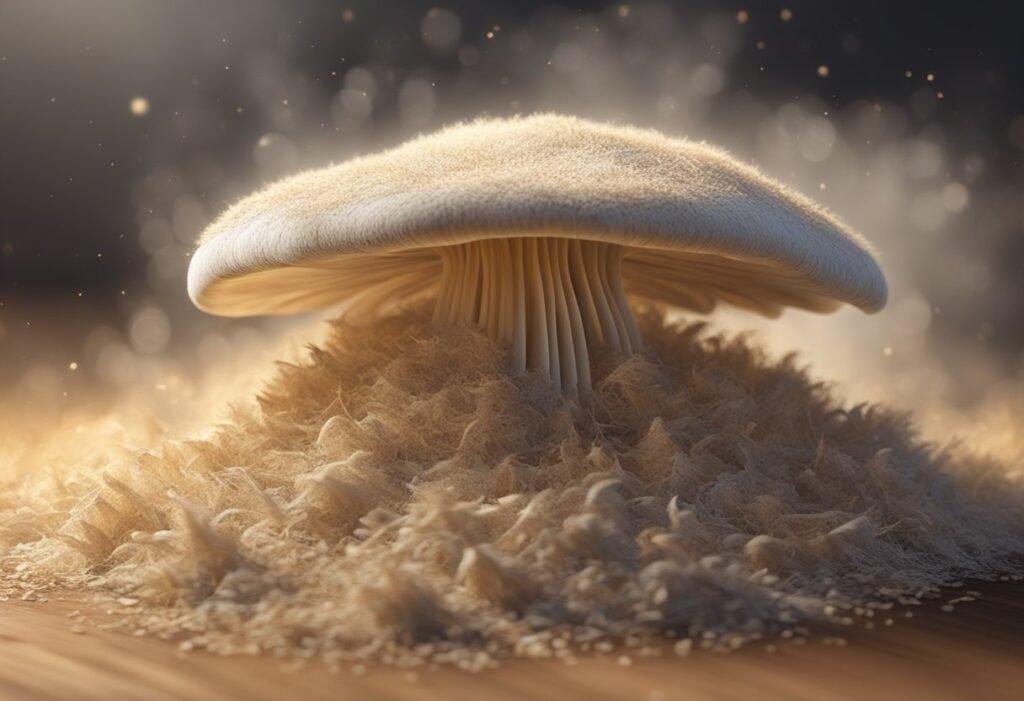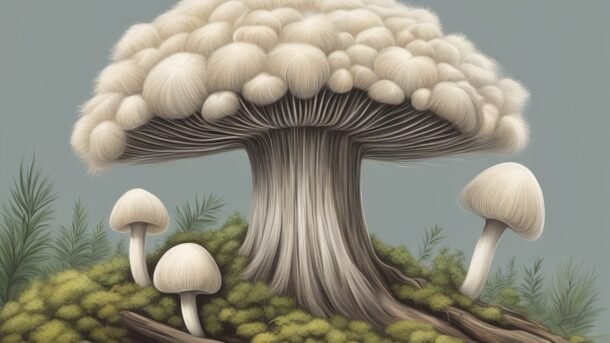Lion’s Mane mushrooms are a delicious and nutritious addition to any diet. They are also relatively easy to grow at home, whether you have a large outdoor space or just a small apartment. With the right materials and techniques, you can enjoy a steady supply of fresh Lion’s Mane mushrooms year-round.
One of the first steps in growing Lion’s Mane mushrooms is selecting a suitable substrate. Hardwood sawdust or supplemented hardwood pellets are good options, as is straw. You will also need to inoculate the substrate with spores or spawn and allow for colonization before triggering fruiting.
There are different methods for growing Lion’s Mane mushrooms, including on logs outdoors or in a fruiting chamber indoors. The ideal temperature for incubation is between 70-75°F (21-24°C). With the right conditions and some patience, you can successfully grow your own Lion’s Mane mushrooms and enjoy their unique flavor and health benefits.
Understanding Lion’s Mane Mushroom

Species Overview
Lion’s Mane Mushroom, also known as Hericium erinaceus, is a type of edible mushroom that is native to North America, Europe, and Asia. It is a unique-looking mushroom that has a white, shaggy appearance, resembling a lion’s mane. The mushroom grows in clusters on trees, particularly on hardwoods.
Lion’s Mane Mushroom is a popular ingredient in many cuisines around the world, and it is known for its delicate, sweet flavor and meaty texture. It is also used in traditional medicine as a natural remedy for various health issues.
Health Benefits
Lion’s Mane Mushroom is not only delicious but also packed with health benefits. It is a rich source of various nutrients, including protein, fiber, vitamins, and minerals. Here are some of the potential health benefits of Lion’s Mane Mushroom:
- Boosts brain function: Lion’s Mane Mushroom contains compounds that may stimulate the growth of brain cells and improve cognitive function. It may also help reduce inflammation and oxidative stress in the brain, which can lead to better memory, focus, and mood.
- Supports the immune system: Lion’s Mane Mushroom contains beta-glucans, which are complex sugars that may enhance the immune system’s response to infections and diseases. It may also help reduce inflammation and protect against certain types of cancer.
- Improves heart health: Lion’s Mane Mushroom contains compounds that may help lower cholesterol levels and reduce the risk of heart disease. It may also help improve blood flow and reduce inflammation in the body.
Overall, Lion’s Mane Mushroom is a nutritious and delicious food that may offer various health benefits. Whether you are a food enthusiast or a health-conscious individual, incorporating Lion’s Mane Mushroom into your diet is definitely worth considering.
Cultivation Requirements

Optimal Growing Conditions
Lion’s mane mushrooms are sensitive to temperature and humidity. The optimal temperature range for growing lion’s mane is between 60°F and 85°F (about 15°C to 30°C), and the humidity should be kept at 80% or higher. If the temperature or humidity falls outside of this range, the growth rate of the mushrooms will be affected.
Another important factor to consider is lighting. While lion’s mane mushrooms do not require direct sunlight, they do require indirect light to grow properly. A well-lit room or a room with a natural light source will provide the necessary lighting for the mushrooms to grow.
Substrate Preparation
The substrate is the material that the mycelium (the root structure of the mushroom) grows on. Lion’s mane mushrooms require a substrate that is high in cellulose and lignin, such as hardwood sawdust or wood chips. The substrate should be sterilized to kill any competing organisms that may be present.
One popular substrate recipe for growing lion’s mane mushrooms is a combination of hardwood fuel pellets, wheat bran, and water. The recipe for a 5-pound block is as follows:
- 5 cups of hardwood pellets
- 1 heaping cup of wheat bran
- 6 cups of water
The substrate should be mixed thoroughly and then packed into a grow bag or container. The grow bag or container should be sterilized before adding the substrate.
Once the substrate is prepared, the mycelium can be added. The mycelium can be obtained from a spore syringe or a culture plate. The mycelium should be added to the substrate and then left to colonize for several weeks.
By following these cultivation requirements, you can successfully grow lion’s mane mushrooms at home.
Inoculation Process
Growing Lion’s Mane mushrooms requires a sterile environment to ensure that the mycelium has no competition from other fungi or bacteria. The process of inoculation involves introducing the mushroom spores or mycelium to a sterile substrate, which will act as the food source for the mushroom to grow. Here are two common methods for inoculating Lion’s Mane mushrooms:
Spore Syringe Method
Using a spore syringe is a popular method for inoculating the substrate with Lion’s Mane spores. The spore syringe is a sterile syringe that contains a suspension of spores in water. Here are the steps involved in the spore syringe method:
- Sterilize the substrate: The substrate can be sterilized by boiling it in water or by pressure cooking it. The substrate should be allowed to cool before inoculation.
- Shake the spore syringe: The spore syringe should be shaken well to ensure that the spores are evenly distributed in the water.
- Inoculate the substrate: The spore syringe should be injected into the substrate, and the needle should be moved around to distribute the spores evenly.
- Incubate the substrate: The inoculated substrate should be placed in a warm, dark place to allow the spores to germinate and the mycelium to grow.
Grain Spawn Technique
The grain spawn technique involves using a sterile grain as a substrate for the mycelium to grow on. The grain is first sterilized and then inoculated with the mycelium. Here are the steps involved in the grain spawn technique:
- Sterilize the grain: The grain should be sterilized by boiling it in water or by pressure cooking it.
- Inoculate the grain: The sterilized grain should be inoculated with the mycelium. This can be done by injecting the mycelium into the grain or by adding a small amount of mycelium to the grain and shaking it to distribute the mycelium evenly.
- Incubate the grain: The inoculated grain should be placed in a warm, dark place to allow the mycelium to grow.
- Transfer the mycelium: Once the mycelium has fully colonized the grain, it can be transferred to the final substrate, such as sawdust or straw, for the mushrooms to grow.
Both methods require a sterile environment and careful handling to ensure success. The spore syringe method is simpler and requires less equipment, but the grain spawn technique has a higher success rate and produces more consistent results.
Growth and Maintenance
Monitoring Growth
Once the substrate is inoculated, the mycelium will begin to grow and colonize the substrate. It’s important to monitor the growth of the mycelium to ensure that it’s healthy and progressing as expected. Check the substrate regularly for signs of contamination, such as mold or unusual odors. If contamination is detected, remove the affected substrate immediately to prevent it from spreading to the rest of the substrate.
To monitor the growth of the mycelium, the grower can use a clear plastic bag or container to provide a view of the substrate. This can help to detect any growth issues, such as slow growth or stalled growth.
Environmental Control
Lion’s mane mushrooms require specific environmental conditions to grow successfully. The temperature should be maintained between 65-75°F (18-24°C) during the incubation period and between 55-65°F (13-18°C) during fruiting. The humidity level should be kept between 85-95% during the incubation period and between 90-95% during fruiting.
The grower can use a humidifier or a spray bottle to maintain the humidity level. A thermometer and a hygrometer can be used to monitor the temperature and humidity levels. Proper ventilation is also important to prevent the buildup of carbon dioxide and to promote the exchange of fresh air.
By monitoring the growth and controlling the environmental conditions, the grower can ensure a successful harvest of lion’s mane mushrooms.
Harvesting and Storage
Harvesting Techniques
When it comes to harvesting Lion’s Mane mushrooms, it is important to wait until they reach their full size. This will ensure that they have reached their optimal flavor and texture. The ideal time to harvest Lion’s Mane mushrooms is when they are between 4-6 inches in diameter. To harvest the mushrooms, use a sharp knife to cut the stem close to the base of the mushroom. It is important to avoid pulling the mushroom out of the substrate, as this can damage the mycelium and reduce future yields.
Proper Storage Methods
Once harvested, it is important to properly store Lion’s Mane mushrooms to maintain their flavor and freshness. The mushrooms should be stored in a paper bag or wrapped in a paper towel to allow for air circulation. Avoid storing the mushrooms in plastic bags, as this can cause them to become slimy and spoil more quickly.
Lion’s Mane mushrooms can be stored in the refrigerator for up to one week. To extend their shelf life, they can also be dried or frozen. To dry the mushrooms, slice them thinly and place them on a baking sheet in a single layer. Dry them in an oven set to the lowest temperature for several hours until they are fully dehydrated. To freeze the mushrooms, slice them and place them in a single layer on a baking sheet. Freeze them until they are firm, then transfer them to a freezer-safe container. Frozen Lion’s Mane mushrooms can be stored for up to 6 months.
By following these simple harvesting and storage techniques, you can enjoy the delicious flavor and health benefits of Lion’s Mane mushrooms all year round.




